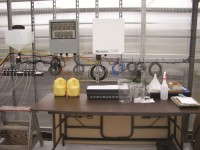Manage pH And Soluble Salts In Hydroponics

Hydroponic greenhouse production has garnered increasing interest nationwide. For growers transitioning from greenhouse container production to hydroponics, it is important to be aware of some differences in monitoring pH and EC (electrical conductivity, a measure of soluble salts). This article discusses these differences and presents a case study in pH and EC monitoring.
Acquiring Target pH In Hydroponics Takes Practice
Many container substrate components such as peat, vermiculite, coir and wood products have a moderate buffering capacity for pH. That means it takes large changes in fertilization or acid injection to bring about a modest change in pH. For example, when we observed high pH in 4-inch bedding plants, we switched temporarily to a very acidic fertilizer (100 percent of nitrogen from ammonium/urea instead of 40 percent), it took about a week for a pH change of about 0.5 to 1.0 units to take place. In contrast, pH can change much more dramatically in hydroponic production because water and inert substrates such as perlite or rockwool have very little pH buffering. We have frequently observed pH changes of 1 to 2 units in one day.
In containerized production, it is usually recommended to monitor root-zone pH using the PourThru or 1:2 dilution method once every week or two. In hydroponics, it is critical to monitor pH at least every day. The pH may be monitored by hand — that is, sampling the nutrient solution being circulated to the roots. Alternatively, monitoring may be done continuously using an automated system. These systems vary in their level of sophistication and cost. Sensors that continuously monitor and digitally display pH and EC are on the less expensive end of the spectrum. Other systems can be connected to dataloggers or computers to record values, and high-end integrated systems that use measured values and target thresholds to adjust pH and EC are more expensive.
The target nutrient solution pH in hydroponics is similar to suggested root-zone pH in container production — about 5.5 to 6.5 depending on the crop. To ensure adequate availability of micronutrients in hydroponics, the lower side of these recommendations is often followed, such as a target pH of 5.5. When pH adjustment needs to be made, the tools to solve the problem are also essentially the same as in container production: adjusting the nitrogen form in the fertilizer or adding acid or base. Ammonium and urea are acidic forms of nitrogen, whereas nitrate will increase the pH. By adjusting the ratio of nitrogen sources in the fertilizer solution, pH can be controlled.
With respect to adding acids or bases when a large water reservoir is used, allow time for sufficient mixing. Check the resulting pH after mixing. Continue to add acid or base if further adjustment is needed. Be careful not to overshoot the mark by adding too much at first. As growers gain experience with the growing conditions, they will have a better idea as to how much to add.
High EC Can Be Problematic In Some Hydroponic Systems
The EC of the hydroponic nutrient solution is a measure of all of the salts dissolved in water, including those added in the fertilizer and those present as impurities in the water source. When the water source is relatively pure, the EC is a decent indicator of the fertilizer available to the plant. EC targets vary by crop but are often in the range of 1.0 to 2.0 mS/cm from the fertilizer plus the EC contribution from the water source. A low EC indicates that not enough fertilizer is being supplied to meet plant needs.
In closed hydroponic systems where irrigation water is captured and reused, high EC is a more common problem. This occurs when the non-fertilizer salts and any fertilizer ions supplied above plant needs remain in the nutrient solution and accumulate. Many hydroponic growers find it necessary to filter their tap water so that it is suitable for closed hydroponic systems.
Just like pH, EC should be monitored more frequently in hydroponics than in container production. Though crops vary in their salt sensitivity, a general recommendation is to avoid EC greater than 4.0 mS/cm. In open hydroponic systems where the irrigation water is not captured and reused, the buildup of salts can be managed by applying excess water to leach out soluble salts. In closed systems you will need to “bleed” the reservoir, which involves purposely draining off some fraction of the nutrient solution and replacing it with fresh water.
It is important to get a laboratory analysis of the nutrient solution every week or two to determine the actual nutrients that make up the EC. The solution may be at target EC levels, but if most of this is from non-fertilizer salts that have accumulated, such as bicarbonates, sodium and chloride, then the solution may still be low in fertility. The lab results can also be used to adjust the specific fertilizer ions to make the nutrient solution better balanced to crop needs.
Study Looks At pH And EC Control
To investigate and demonstrate the importance of pH and EC control in hydroponics, a research laboratory was designed and constructed in a greenhouse at the Ohio Agricultural Research and Development Center in Wooster, Ohio, in the spring of 2008. The laboratory consisted of 16 troughs designed to grow lettuce using the nutrient film technique (NFT). The water and nutrient delivery system was capable of randomly and simultaneously delivering different treatments to each of the growing channels using eight solution tanks. Each growing channel was 12 feet long and designed to grow 18 plants 8 inches apart. A datalogger was used to record environmental conditions and nutrient solution temperature.
To gain experience with this new laboratory, nutrient solution pH and EC targets were compared at two levels: pH targets of 5.4 or 6.0 and EC targets of 1.4 or 1.8 mS/cm. Lactuca ‘Rex Bibb’ and Lactuca ‘Green Leaf’ seeds were germinated in 1-inch-by-1-inch-by-1.5-inch grow cubes. The seedlings were transplanted to the growing channels in October 2008 and harvested four weeks later. A pH setting of 5.4 led to 24 percent higher yields than a pH of 6.0, while the main effect of setting EC at 1.4 compared to 1.8 mS/cm was nearly zero.
While extensive efforts were made to manually monitor and modify nutrient solution pH two to three times per day during this first experiment, pH readings were consistently found to be higher than either of the targets that were set for the experiment. These measurements showed that the pH of the nutrient solution was rising faster than we could manually modify it with dilute sulfuric acid on a two- to three-times-per-day basis. It often climbed 1 pH unit higher than the set points within a few hours.
Even though daily measurements showed EC control was reasonably consistent, it is likely that pH was too high, and therefore, extra nutrients that should have been accessible to the lettuce plants when the EC target was set to 1.8 were not available. We concluded that if pH was not kept on target in follow up experiments, the potential impact of high settings of EC on yield would not be realized.
Control pH To Improve Nutrient Use
These observations led to the purchase and installation of a pH control unit for all eight tanks prior to the second experiment in the spring of 2009. This control system can be set to measure and modify pH in each tank individually on a minute-by-minute basis, thus maintaining acid concentrations on target. It consists of a complex of eight panel-mounted Hanna mini pH indicators and controllers from Hanna Instruments in Woonsocket, R.I., that were connected to eight Bluelab pH probes from Bluelab Corporation Limited in New Zealand. One of these probes was installed in each solution tank by floating them on a 15-centimenter-by-15-centimeter-by-2.5-centimenter thick Styrofoam pad.
The overall average fresh weight for lettuce grown during the Fall 2008 experiment was 119 grams per head compared to 162 grams for the Spring 2009 experiment. While differences in climate may have contributed to higher yields in the spring, another possible explanation for the increase may have been more accurate pH control. Note that the impact of setting EC = 1.8 as opposed to EC = 1.4 led to a 17 percent greater yield compared to only a 5 percent advantage for a pH setting of 5.4 versus 6.0. Recall that there was little or no advantage for the setting EC = 1.8 during the first experiment when pH was not controlled successfully. Accurately controlling the pH allowed nutrients to be used more effectively throughout the growing period.
Growing hydroponically allows for more precise control of nutrient solution pH and EC than in containerized production. To optimize crop yield, however, EC and pH must be more frequently monitored as compared to container production.









